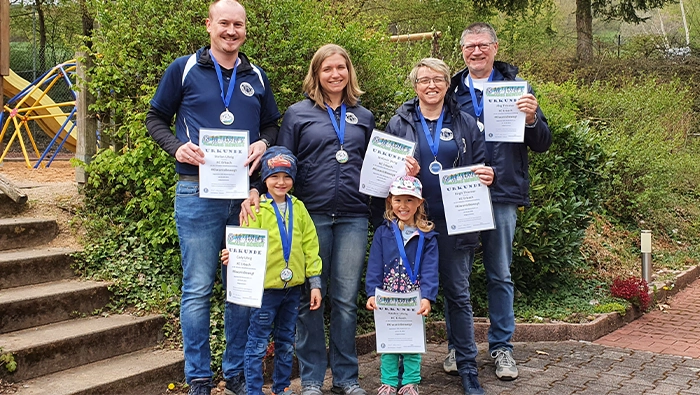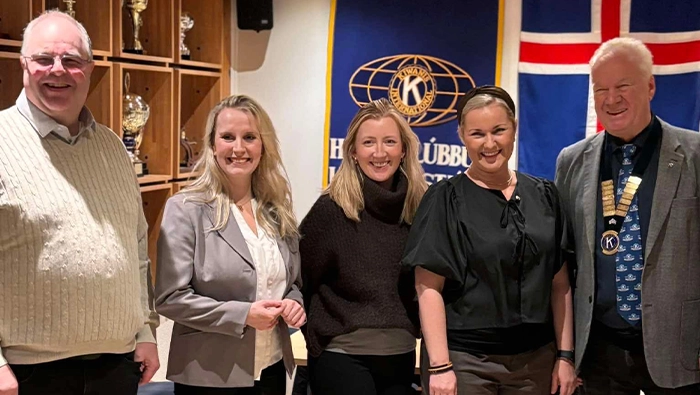
A Kiwanis club’s family influence
German Kiwanian Stefanie Uhrig reflects on starting and serving in a club with her family.
By Tony Knoderer
Since it was chartered in 2014, the Kiwanis Club of Erbach/Odenwald, Germany, has been an important part of Stefanie Uhrig’s family — and vice versa. Uhrig herself became the club’s charter president after her husband, inspired by playing in a Kiwanis-sponsored golf tournament with his father in Austria, opened the club.
“My husband and his father were invited by a client, and at first they thought that Kiwanis was the name of the golf club,” she says. “But as soon as that confusion was cleared up, my husband started developing the idea of founding our own Kiwanis club.”
Uhrig’s own parents then joined as charter members. Her father-in-law eventually joined as well.
More than a decade later, the club consists of nearly 40 members. We asked Uhrig to share some thoughts via email on Kiwanis and her family’s service. Our exchange is below.
Kiwanis: Why was your family enthusiastic about chartering a Kiwanis club?
Uhrig: My family and I have always had a wonderful relationship, working together in various areas. It felt natural to ask them to join us in founding the club, and they were immediately on board. By now, my father has also been club president for a time. My mother has been treasurer for years now, and we couldn’t imagine anyone else doing the job half as well. We just work really well together as a team, but we all have made various new friendships thanks to Kiwanis — in our club, in Germany and internationally.
K: How has being in a club with various members of your family influenced how you see Kiwanis?
U: I don’t believe that having my close family as part of the club has changed the way I see my membership or how I see Kiwanis, since we’ve started this journey together. But I do believe that had I joined Kiwanis on my own, I might not be as involved. I love spending time with my family, and the fact that I can combine seeing them and taking part in Kiwanis activities makes it much easier to participate.
K: How did your father-in-law come to be part of the club?
U: My father-in-law was actually the founding stone of our charity service. He had been a very active member of the local Rotary club for a long time. My husband and I had helped at various Rotary events before we got to know Kiwanis. Unfortunately, the local Rotary club is a little difficult (and at the time it didn’t allow women to join, which has changed since then).
That was why my husband was so excited by the idea of founding a Kiwanis club comprised of motivated, energetic and friendly people. My father-in-law stayed a Rotarian for a time out of loyalty but realized that he was much more suited for our Kiwanis club, so he left Rotary and joined us.
K: What is the advantage for a club when multiple generations of a family (or families) are members?
U: I suppose that depends on the relationship of the family members. There’s always a danger of carrying family matters into the club or vice versa. But since our family is very loving and able to work together very well and very respectfully, we benefit from enjoying our mutual company at the events. We also know our strengths and weaknesses very well. We can see when one of us needs support with an event, and sometimes the routes of communication are much shorter than if we weren’t in close contact throughout the week anyway.
K: Your children [ages 7 and 9] help at some club events. Do you hope they become fellow Kiwanians someday?
U: Yes, I do hope that our children will join our club once they are old enough. (Or another Kiwanis club, should they live elsewhere.) It is very important for us to convey our values of helping others to our kids. Should they choose to live these values in another way, we would be just as happy, though. It wouldn’t have to be Kiwanis if it doesn’t feel right to them. There are many good ways of helping people. Kiwanis is the way to go for my husband, my parents, my father-in-law and for me, and maybe it’ll be the right one for our little ones.
K: What do you hope your children learn about Kiwanis (and service in general)?
U: I hope they can see that helping others is a lot of fun. I hope they can appreciate all they have, and that others deserve just as much as we do. For now, they are very happy to help at various events, and they understand that sometimes it also takes work, but it is always worth it.
K: What did you learn about your family while opening the club?
U: Nothing I hadn’t known already: That I can always count on them, that they are very well organized, know what they are doing, and that they just know how to make things work. We already knew that we’re great together.
K: What would you say to encourage other members to have younger generations of their families join Kiwanis?
U: It is just a great way of sharing something special, to spend more time together and help other people in the process. As with all younger members, younger family members can of course bring new ideas and fresh looks at everything.


